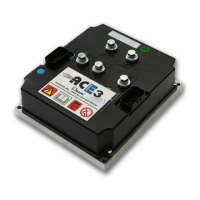Page – 38/139 AFFZP0BB – ACE3 – User Manual
2) The study of the immunity can be divided in two main branches: protection from
electromagnetic fields and from electrostatic discharge. The electromagnetic
immunity concerns the susceptibility of the controller with regard to
electromagnetic fields and their influence on the correct work made by the
electronic device. There are well defined tests which the machine has to
undergo. These tests are carried out at determined levels of electromagnetic
fields, simulating external undesired disturbances and verifying the response.
The second type of immunity, to ESD, concerns the prevention of the effects of
electric current due to excessive electric charge stored in an object. In fact,
when a charge is created on a material and it remains there, it becomes an
“electrostatic charge”; ESD happens when there is a rapid transfer from one
charged object to another. This rapid transfer has, in turn, two important effects:
- This rapid charge transfer can determine, by induction, disturbs on the
signal wiring thus causing malfunctions; this effect is particularly critical in
modern machines, with serial communications (CAN bus) which are spread
everywhere on the truck and which may carry critical information.
- In the worst case and when the amount of charge is very high, the
discharge process can determine failures in the electronic devices; the type
of failure can vary from a temporary malfunction to a definitive failure of the
electronic device.
4 IMPORTANT NOTE: it is always much easier and cheaper to avoid ESD from being
generated, rather than increasing the level of immunity of the electronic devices.
There are different solutions for EMC issues, depending on level of emissions/
immunity required, the type of controller, materials and position of the wires and
electronic components.
1) EMISSIONS. Three ways can be followed to reduce the emissions:
- SOURCE OF EMISSIONS: finding the main source of disturb and work on
it.
- SHIELDING: enclosing contactor and controller in a shielded box; using
shielded cables;
- LAYOUT: a good layout of the cables can minimize the antenna effect;
cables running nearby the truck frame or in iron channels connected to truck
frames is generally a suggested not expensive solution to reduce the
emission level.
2) ELECTROMAGNETIC IMMUNITY. The considerations made for emissions are
valid also for immunity. Additionally, further protection can be achieved with
ferrite beads and bypass capacitors.
3) ELECTROSTATIC IMMUNITY. Three ways can be followed to prevent
damages from ESD:
- PREVENTION: when handling ESD-sensitive electronic parts, ensure the
operator is grounded; test grounding devices on a daily basis for correct
functioning; this precaution is particularly important during controller
handling in the storing and installation phase.
- ISOLATION: use anti-static containers when transferring ESD-sensitive
material.

